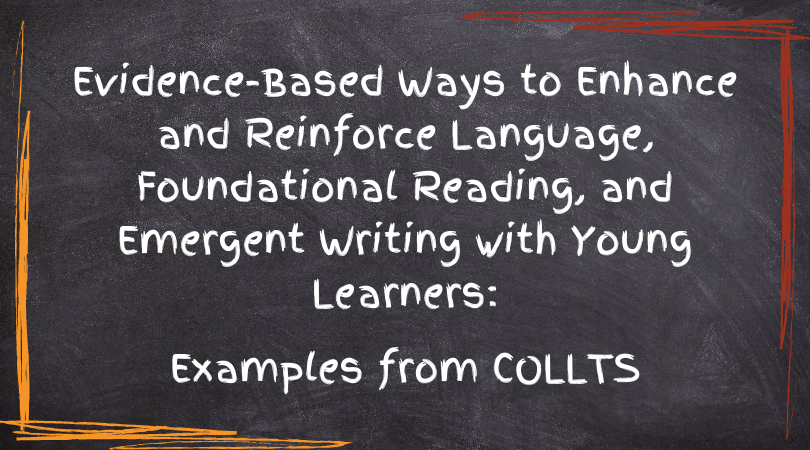 In this article, Lauren Artzi, Rebecca Bergey, and Patricia Garcia-Arena explore ways in which educators can use the COLLTS (Cultivating Oral Language and Literacy Talent in Students) program to promote successful reading and writing skills in young learners, including dual language learners (DLLs).
In this article, Lauren Artzi, Rebecca Bergey, and Patricia Garcia-Arena explore ways in which educators can use the COLLTS (Cultivating Oral Language and Literacy Talent in Students) program to promote successful reading and writing skills in young learners, including dual language learners (DLLs).
Reading and writing are complex processes—and they are challenging for all students, dual language learners (DLLs), included.
For a student to successfully read a text and understand what they are reading, they must deploy both word recognition and language comprehension skills (Gough and Tunmer, 1995).
- Word recognition includes phonological awareness, decoding, phonics—the skills that allow readers to recognize and map sounds of letters to words for effective and efficient word recognition.
- Language comprehension abilities allow a reader to make sense of the text.
For DLLs, this includes an added level of complexity, given that they are navigating two language systems, and often still developing comprehension and other skills in their first language, as they develop a second.
With writing, there is an additional layer of difficulty for students. Writing is expressive and requires producing language, in contrast to receptive language, which involves recognition, such as through listening or reading. To write, students must have not only ample executive functioning, but also transcription and text generation skills (Al Otaiba et al., 2018). Fortunately, DLLs have been shown to have advantages in skills such as executive functioning (see our first blog post in this series for more detail), which may help in language and literacy development (in one or both languages).
Educators can use shared interactive reading and writing practices to help foster and reinforce key language, print concepts, foundational word recognition, and emergent writing skills—all necessary for young children to develop into successful readers and writers, whether they are monolingual or emerging bilinguals. The Cultivating Oral Language and Literacy Talent in Students (COLLTS) program offers educators multiple ways to do this, in both English and Spanish. In our first blog post, we introduced you to the program. In this blog post, we go into further depth, providing more examples of COLLTS in practice and the research behind the program. [1][2]
Language
We know that children need language to understand what they are reading (see report from National Early Literacy Panel for more information). As such, enhancing language opportunities in the classroom should include vocabulary instruction, as well as engaging students in rich discussions. In early elementary classrooms, teachers can work with students on understanding prefixes and suffixes, as well as context clues and word refence skills. They also can focus on reading strategies such as predicting, summarizing, asking, and answering questions.
Promoting Vocabulary
Do you remember what it is like to encounter vocabulary challenges while reading? You can refresh your memory by reading a page from a subject you have no experience with, say a functional genomics journal article or a nautical book. You also might cover up connective words like “moreover” and “therefore” in a text, to see how the lack of understanding those “signposts” affects reading. Exercises like these can help educators understand why it is so important to focus instructional time on vocabulary learning of young children—even at the earliest of ages.
When working with students on vocabulary, educators should focus on words that are important for understanding the meaning of the story. It can be helpful to provide opportunities for children to hear and use other words that are connected conceptually with the target words, thus extending children’s oral language and background knowledge.
In COLLTS, educators teach students focus words through:
- Connecting the word to a picture, kinesthetic activity, demonstration, or real situation.
- Providing the word in English and other languages.
- Calling attention to cognates, or those words that sound alike, look alike, and mean similar things.
- Providing a child-friendly explanation of the word in English and other language.
- Talking about examples and non-examples.
- Providing opportunities to talk about the word, and giving a sentence stem with the target word as a scaffold, if necessary; and
- Calling attention to the beginning sounds and letters in the words.
Expanding Language
Language is broader than simply vocabulary. Children make sense of how language is structured through oral communication and apply appropriate grammar rules at the text level. While developing language, it is natural for a child to make mistakes, apply conventions inappropriately, or not expand upon thoughts as they are speaking. COLLTS uses a particular strategy—called recasting and expanding—to encourage educators to model appropriate language skills, which helps students learn.
Recasting involves taking children’s language and repeating their statement using correct grammar and sentence structure. For example, when playing with a stuffed animal, a child might say, “Bear no like tea.” To recast, the child’s caregiver or teacher could respond with, “Ok, your teddy bear does not like tea. Does your teddy bear like juice?” You will notice here that the child used an incorrect grammatical structure, and the adult responded by correctly framing the statement and adding on to the statement. Expanding involves taking children’s language and rephrasing their comments using more specific, or complete sentences. For example, a child might say, “Soap makes bubbles.” To expand, the caregiver might say. “That’s right. When we wash dishes, we use soap and water to clean the dishes. When we mix soap and water, it makes bubbles.”
Print Concepts and Foundational Word Recognition
In addition to enhancing language and comprehension, learners in early childhood education classrooms benefit from instruction that helps them understand concepts of print and begin to recognize sounds of words, through letter recognition and phonological awareness activities. These skills lay the foundation for word recognition skills that readers will need to decode a page of text.
Print concepts involve how print is organized, such as where the title is located, where the author’s name is placed, and where to start reading on a page. In COLLTS, before the reading session begins each day, the teacher shows students the direction the book opens and the direction of the language in the book. They also discuss the role of the author and illustrator and where to find text features, if relevant.
Phonological awareness is the ability to detect, manipulate, and use language’s sound structure. In COLLTS, this concept is practiced in a brief game that happens after the shared interactive reading activity and before the writing activity. For example, to reinforce syllables as part of phonological awareness, the teacher says a word from the story and asks the students to clap for the number of syllables.
Alphabetics is where children can name the letters of the alphabet. In COLLTS, brief phonological awareness and alphabetics activities are infused into the vocabulary learning routine. At the end of the introducing the vocabulary word, the teacher calls attention to the first letter of the word and what sound it makes. For example, in teaching the word excellent, teachers ask students to say the name of the letter” e” and produce its sound(s).
Emergent Writing
COLLTS also addresses the three kinds of writing referenced in college and career ready standards: narrative, informational, and argumentation. For instance, the conclusion of each COLLTS unit provides an opportunity for young learners to practice their emergent writing through shared interactive writing connected to the unit text. Students first co-construct a shared writing piece in the group with the teacher, allowing them to see models.
In one COLLTS book, Lola Goes to the Library, the narrative writing prompt is, “What is your favorite part of the book?” Using chart paper, the teacher elicits responses from the children and writes their thoughts. A young child might say, “I like when Lola pretend farmer … I like farm.” The teacher writes the corrected form of the sentence on the chart paper, “I like when Lola pretends to be a farmer because I like farms.” The teacher might use the opportunity to explicitly point out some transcription considerations—such as capitalization and punctuation, and language considerations, like using the connective word because. The teacher writes this word because it is in red so that it is highlighted for students in context. After the group writing period, each child receives an individual writing page with the same prompt. Now they can “write” their own response. Depending on their developmental level, children might “write” by illustrating or dictate their individual writing as their teacher or another adult writes their response.
Planning for Shared Reading and Writing
As described in our first blog post, using shared interactive reading and writing techniques as part of instruction in early childhood and early elementary classrooms can support young learners’ initial literacy skill development.
For educators who plan to include these learning events in the classroom, consider the following planning questions:
- What text will you use for the shared reading? Does it include rich and diverse language and story themes?
- How will you engage children with the book in a way that enhances discussion?
- How are you going to introduce the book?
- Where are you going to stop to ask questions in the reading?
- How are you going to promote student discussion during the reading?
- What scaffolds (i.e., response frames, modelling, visuals) might you provide to expand students’ responses?
- What practices can you include to support multi-lingual learners across reading and writing activities?
- What vocabulary will you target in the shared interactive reading and writing? How will you draw attention to cognates?
- What activities can you plan to align with the shared interactive reading time to support children’s:
- Language development?
- Print concepts?
- Foundational word recognition skills, such as alphabetics and phonological awareness?
- When will shared interactive writing occur? What is the focus text-type (narrative, informational, argumentative)?
For more ways to support children’s language and literacy development, see our other blog posts in this series:
Addressing the Overwhelming Need for an Early Childhood Program Focused on Young Dual Language Learners

Dr. Lauren Artzi – Senior Researcher at the American Institutes for Research (AIR).

Dr. Rebecca Bergey – Senior Researcher at the American Institute for Research (AIR).

Dr. Patricia García-Arena – Principal Researcher at the American Institutes for Research (AIR).
The Center for English Learners at AIR is committed to reducing the achievement gap and improving outcomes for English learners by connecting rigorous research to policy and practice. In addition to professional development related to COLLTS, Center staff conduct research related to teaching and learning; perform policy studies; provide technical assistance to states and districts to enhance English language learning; and support schools in implementing Attaining Core Content for English Language Learners (ACCELL), the AIR research-based approach for supporting teachers with English learners in their classrooms.








